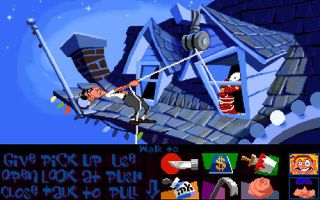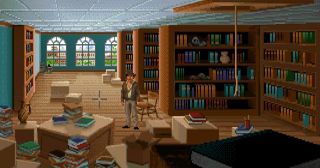
Phoenix was technologically innovative, too, blending handpainted backgrounds with motioncaptured animations, a technique that became known in-house as ‘Dave’s special process’. Grossman chuckles at the memory. “We had a VO guy called Mike Levine... we got him a hard drive that was a whole gigabyte, and it was this massive expensive thing; it was the biggest one you could get at the time,” he says. “We filled it up in a week, and they were like, ‘Can we get another one?’ And we were like, ‘No.’”
There were a number of reasons behind Phoenix’s cancellation, but the main one was a realisation on the corporate side of LucasArts that 30% of its adventure-game market was in Germany. The studio feared that this would impact on sales due to laws against depictions of Hitler and Nazism at the time. As a result, the team were asked if they could drop the Nazis from the game. “We were like, ‘Not easily,’” Grossman recalls. “We could’ve started over and done that, but it would’ve disrupted the entire design.” In the end, they figured that if they did have to start over, it might as well be on a new project. Their work wasn’t entirely wasted, as Phoenix’s story was eventually published as a Dark Horse comic series.
The period after Phoenix’s cancellation was when LucasArts’ production of adventure games slowed down, with 1999’s Grim Fandango being the last bona-fide classic from the studio. But, despite evidence to the contrary, the adventure-gaming spirit never left LucasArts. The early 2000s saw two sequels to Full Throttle and a sequel to Sam & Max put into production. Paul Pierce, who worked on the UI for Full Throttle 2: Hell on Wheels, remembers the project: “It was a Sean Clark/Mike Stemmle project, with Chris Miles as the art director. I don’t recall how long this was in production before it was cancelled, but it seemed like at least a year. It was a big team and a lot was made for the project.” Developed during 2002, Hell on Wheels was cancelled because of negative reactions to the game’s dated 3D graphics, while the unfortunate demise of Roy Conrad, the voice actor for chief protagonist Ben, was also rumoured to be a contributing factor.
This troubled period of LucasArts’ history is fairly well documented. Both Hell on Wheels and Freelance Police are famous heartbreakers, often viewed as the final death throes of LucasArts’ adventuregaming pedigree. Less is known about what came after. Around 2008, a new LucasArts president was ushered in (the studio had almost as many presidents as it did games), who wanted to build smaller titles to take advantage of mobile platforms and digital distribution. LucasArts producer Craig Derrick, employed there since 2006, saw this as a chance to bring back adventure games: “That became something we referred to internally as Heritage. Heritage group was responsible for bringing life back into those titles.”

This began with the Monkey Island Special Editions released in 2009/10, and the Tales of Monkey Island series developed by Telltale. Unfortunately, that’s as far as Heritage ever got, though Derrick and his team had plans for far more. Derrick had talks with Ron Gilbert and Tim Schafer to do a ‘true’ Monkey Island 3, according to their original vision. “I found some notes and design docs that hinted at that, so that was on the table,” recalls Derrick, “and then, unfortunately, LucasArts changed direction again.”
In addition, Derrick wanted to do either a remaster or a remake of Maniac Mansion, as part of a longterm plan to create a new Day of the Tentacle game. “In DotT, you could play Maniac Mansion on one of the computers; it was a game within a game,” he says. “I always thought it would be funny to do the flipside of that, to create a new Maniac Mansion and have DotT playable in it.”
Due to managerial turbulence within LucasArts, and its eventual acquisition by Disney, none of this led to anything tangible. Yet, while it may be sad that these games were never created, at least they will be remembered. Indeed, when I first contacted Aric about his personal archives, he joked, “These belong in a museum!” Now, in all likelihood, that’s where they’re headed, to be preserved in the Film and Media Collection at Stanford Museum in the US, along with many designs of completed games. This way, the history of LucasArts—both the told and the untold—will be preserved, and not just to be examined by Top Men.
The biggest gaming news, reviews and hardware deals
Keep up to date with the most important stories and the best deals, as picked by the PC Gamer team.
Most Popular


